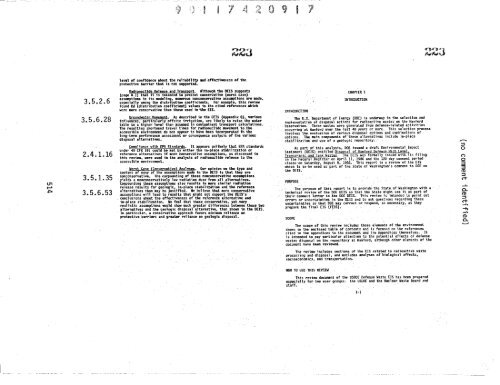EIS-0113_Section_11 - Hanford Site
EIS-0113_Section_11 - Hanford Site
EIS-0113_Section_11 - Hanford Site
Create successful ePaper yourself
Turn your PDF publications into a flip-book with our unique Google optimized e-Paper software.
y ^ '^ q6 a `^ —;E 4 rf<br />
JWL9<br />
lid d^d'a_)<br />
Ln<br />
N<br />
level of confidence about the reliability and effectiveness of the<br />
protective barrier that is not supported.<br />
Radionuclide Release and Transpo rt . Although theD<strong>EIS</strong> suggests<br />
(page 0.1) that it is Intended to present conservative (worst case)<br />
assumptions in its modeling, numerous nonconservative assumptions are made,<br />
3.5 * 2, 6 especially among the distribution coefficients. For example, this re view<br />
found Kd (distribution coefficient) values in the cited references which<br />
were more conservative than those used inthe <strong>EIS</strong>.<br />
3.5<br />
.6.28<br />
6roundwate Movement. As described in the D<strong>EIS</strong> (Appendix Q), various<br />
influences, -particularly offsite irrigation, are likely to raise the water<br />
table to a higher level than assumed in contaminant transport calculations.<br />
The resulting shortened travel times for radionuclide movement to the<br />
accessible amiss rpnmonT do not appear to have been incorporated in the<br />
long-term performance assessment or consequence analysis of the various<br />
.disposal altermati ves.<br />
-- Compliance with EPA Standards. It appears unlikely that EPA standards<br />
under 40 CFR 191 could be at by either the n-place stabilization or<br />
2.4.1.16<br />
reference alte rn atives if more conservative assumptions, as discussed in<br />
this review, were used in the analysts of radionuclide release to the<br />
accessible eavironmont.<br />
3 .5.1.35<br />
3.5.6.53<br />
- Worst Case (Conservativel Analyses, Our opinion mm the type and<br />
-content of many of the assumptions m il e in the D<strong>EIS</strong> is that they are<br />
nonconservative. The compounding of these nonconservative assumptions<br />
yields a. nonconservatively low radiation dose from all alternatives.<br />
Compounding these assumptions also results in mo re similar radiation<br />
release results for geologic, in place stabilization and re the ference<br />
lte, atives in. gay be Justified. We believe that mare conservative<br />
ass umptions will lead to results that might not support the D<strong>EIS</strong>'.<br />
conclusions about the effectiveness of the reference rv alternative add<br />
in-place stabilization. We feel that these conse ative, yet very<br />
realistic assumptions would show much greater differences between these two<br />
alternatives and the geologic rv disposal alternative, than shown in the D<strong>EIS</strong>.<br />
In particular, a conse ative approach favors minimum reliance on<br />
protective barriers and greater reliance on geologic. disposal.<br />
INTRODUCTION<br />
CHAPTER I<br />
INTRODUCTION<br />
The U.S. Department of Energy (ME) is underway in the selection and<br />
fmpl eotatfon of disposal actions for radioactive wastes on the <strong>Hanford</strong><br />
Reservation:' Thesee-wastes were generated from defense-related activities<br />
occurring at <strong>Hanford</strong> over the llast 40 years or more. This selection p rocess<br />
involves the evaluation of various disposal options s and Combinations of<br />
options. The main components of these alternatives include in-place<br />
stabilization and use of a geologic repository.<br />
A part of this analysis, WE issued a draft Environmental Impact<br />
State nt (D<strong>EIS</strong>) entitled i 1 f H f d D f H M1 L 1<br />
d T k W Y The D<strong>EIS</strong> F^ pally issued Mth its filing<br />
in the Federal Register on April <strong>11</strong>, 1986 was and the 120 day com p nt period<br />
closes,on Saturday, August 9,: 1986. This report is a review of the <strong>EIS</strong><br />
which is to be used as Dart of the State of Washington's comment to DOE on<br />
the D<strong>EIS</strong>.<br />
PURPOSE<br />
-<br />
l<br />
The porous. of this report is to p..vade the State of Washington with a<br />
technical review of the DOE D<strong>EIS</strong> so that the State might use it as part of<br />
. their- o t letter to the DOE D<strong>EIS</strong>. This review is intended to point out<br />
errors or certainties in the D<strong>EIS</strong> and to ask questions regarding these<br />
uncertainties So that DOE may correct or respond, as necessary, as they<br />
prepare the final <strong>EIS</strong> (F<strong>EIS</strong>).<br />
-<br />
The sco pe of this review includes those elements of the environment<br />
shown in the enclosed table of contents and is focused on the references<br />
cited in the appendices to the document and the Appendicesthemselves. dt<br />
- is intended to pay particular attention to the potential. effects of defense-<br />
.. wastes disposal on the repository at <strong>Hanford</strong>, although other elements of the<br />
document have been reviewed.<br />
SCOPE<br />
7<br />
O<br />
f)<br />
(D<br />
c<br />
r't<br />
n(D<br />
3<br />
fD<br />
d<br />
v<br />
-<br />
The review includes sections of the <strong>EIS</strong> related to radioactive waste<br />
processing and disposal, and excludes analyses of biological affects,<br />
socioeconomics, and transportation.<br />
'HOW TO USE THIS REVIEW<br />
This review document of the USDOE Defense Waste <strong>EIS</strong> has been prepared<br />
especially for two user groups: the USDOE and the Nuclear Waste Board and<br />
staff.

















